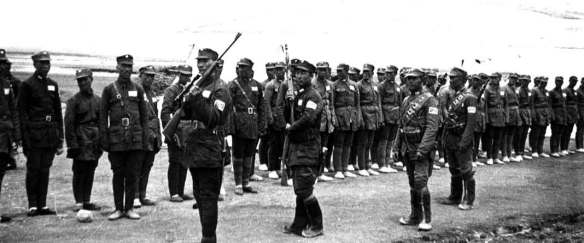
President Franklin D. Roosevelt initially had extremely high hopes for a major contribution by the Guomindang to the defeat of Japan. He authorized a “thirty division plan” to train and equip Chinese troops to engage the Japanese Army on the mainland of Asia. U.S. advisors poured into China in 1942, and Jiang’s paper divisional strength soon reached impressive numbers: over 300 divisions by 1945. However, most of those divisions were poorly manned, badly trained, and underequipped despite the American supply effort, largely because the Japanese Army kept overland supply routes closed for most of the war. Worst of all, too many Chinese soldiers were terribly demoralized. Many fought hard against the ruthless Japanese invader, but others were utterly bewildered and had no understanding of the war or their role in it. Peasant “soldiers” were acquired by brutal conscription methods, with hundreds and even thousands marched out of suddenly surrounded and swept villages and even regions. They were tied together with hemp rope to prevent mass desertion. Many died before reaching their first boot camp. Once in Guomindang uniform, or often still just wearing peasant clothes or rags, Chinese troops were usually poorly led and were hardly fed or clothed. Western soldiers meeting Chinese units in Burma later in the war were shocked to observe that few or none of their allies wore shoes. None had sturdy jungle boots, while many were shod in matted straw. Medical treatment was minimal to nonexistent and death from wounds or disease was ubiquitous. Desertion and attendant executions were therefore chronic.
Nevertheless, with savage conscription methods and brutal discipline, Jiang obtained his needed replacements. By 1941 the Guomindang had nearly six million men nominally under arms. Over the course of the war it conscripted over 14 million into its armies. Most huddled in the south in vast garrisons or were deployed along the extended frontier with Japanese occupation forces. Some carried out effective ambushes and large-scale guerilla operations. But the majority were there to absorb with their suffering and their lives whatever blows the overextended Japanese Army could still deliver. Even if most Guomindang divisions were barely competent as fighting formations and their men deserted at the first—and second and third—opportunity, they were useful to Jiang to suppress local warlords and to threaten the Communists. Most importantly, they kept aid coming into China by impressing with sheer numbers a distant American president eager to avoid casualties, and concerned and committed to train and arm Chinese divisions to fight the bulk of the Japanese Army. The British prime minister and Chiefs of Staff were far less impressed with Jiang’s formations. Eventually, even Roosevelt grew frustrated by Guomindang corruption and incompetence. In 1944 he looked instead to the harder slog through the Central Pacific as the road to victory over Japan. Fighting continued in China, but it was no longer seen by Japan or the Western Allies as strategically important to the outcome of World War II.
The Chinese Civil War resumed on a greatly enlarged scale from late 1945, with events and battles initially favoring the Guomindang. The United States helped air lift Guomindang troops into northern cities abandoned by the withdrawing Japanese and into Manchuria. The Red Army permitted Chinese Communist troops to enter the same territories. When serious fighting broke out among competing Chinese forces in 1946, Guomindang reverses in the field revealed depths of political and personal corruption and incompetence that rose into the top leadership. That made victory over the Communists ever more problematic. The civil war culminated in a Communist military triumph in early 1949, followed by the Communist Revolution. The Guomindang was not militarily defeated in the field—though it indeed lost massively during the Huai-Hai campaign (November 1948–January 1949). It was more important that it collapsed from within, morally, fiscally, and politically. Remnant divisions fled to Taiwan, where in later years they were given just enough arms and support by Washington to fend off an expected invasion by Communist forces, but never enough to themselves counter-invade China. The Guomindang remained politically dominant on Taiwan until the mid-1990s.